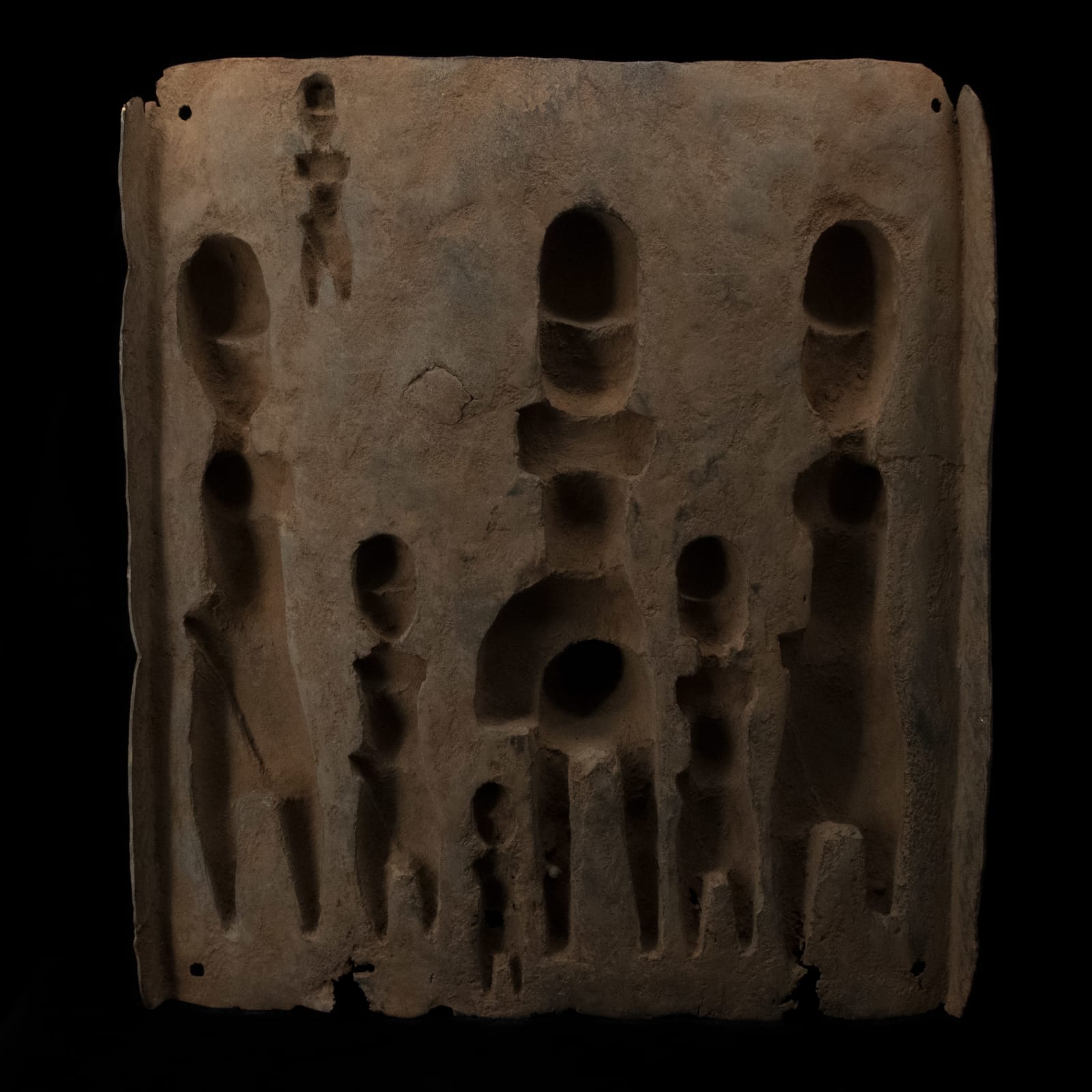Benin Plaque Depicting an Oba and Attendants, 19th Century CE
Bronze
45.5 x 40 x 15 cm
17 7/8 x 15 3/4 x 5 7/8 in
17 7/8 x 15 3/4 x 5 7/8 in
ES.3463
The artworks of the Benin Kingdom, in modern Nigeria, are considered among the most accomplished in Sub-Saharan Africa. Their metalwork, especially bronzes, are legendary. Most Benin artworks were created at...
The artworks of the Benin Kingdom, in modern Nigeria, are considered among the most accomplished in Sub-Saharan Africa. Their metalwork, especially bronzes, are legendary. Most Benin artworks were created at the command of, or as a commemoration of, the powerful god-kings of Benin, the Obas. The palace of the Obas was famed not only for its sprawling size, but also for the fact that the exterior wooden columns were coated, top to bottom, in brass and bronze plaques. The overall effect was a palace of blinding light, shining in the sun. This impressive façade was described in meticulous detail by the first Dutch visitor to the palace, Olfert Dapper. The plaques told a story in relation to one another, and one could ‘read’ the palace simply by walking along it.
The vignette presented in this plaque depicts the Oba on horseback; his facial expression one of refined detachment, he rides towards the viewer. His eyes are wide, and his lips are full. Around his neck are a series of gold circlets, which come right up to his chin. He wears a headband, from which two chains dangle behind either ear. He has a complex tiered hairstyle, the number of tiers demonstrating his seniority. He is shirtless, except for a cross-belt for holding his weapon, and wears a long kilt which reaches down to his feet. On either side of him, two attendants, depicted much smaller than him, hold either hand. Beside them are two warriors, bearded and also wearing cross-belts, who shield the Oba from the sun with their shields. Above the warriors, there is another small figure: he heralds the arrival of the Oba with a trumpet or horn. Each of the attendants has a tiered hairstyle with significantly fewer tiers than the Oba.
Benin art came to the attention of the Western World after the British punitive expedition of 1897. In retaliation for a British trading expedition gone wrong, resulting in the deaths of six British and 200 Africans, the British government punished the Benin Kingdom by killing a great many and burning down Benin City. During the process, the British stole a great many Benin artworks, filling the British Museum and denuding Nigerian collections in the process. The palace bronzes, however, had been removed by the time of the expedition. It is uncertain why, but later scholars have suggested that they were transferred to some kind of library, in which their stories might be consulted.
References: a parallel of the scene can be found in London (British Museum Af1898,0115.38), while a parallel for the trumpeter figure can be found in New York (Metropolitan Museum of Art 1990.332). A very close parallel of the plaque can be found in New York (Metropolitan Museum of Art 1978.412.309).
The vignette presented in this plaque depicts the Oba on horseback; his facial expression one of refined detachment, he rides towards the viewer. His eyes are wide, and his lips are full. Around his neck are a series of gold circlets, which come right up to his chin. He wears a headband, from which two chains dangle behind either ear. He has a complex tiered hairstyle, the number of tiers demonstrating his seniority. He is shirtless, except for a cross-belt for holding his weapon, and wears a long kilt which reaches down to his feet. On either side of him, two attendants, depicted much smaller than him, hold either hand. Beside them are two warriors, bearded and also wearing cross-belts, who shield the Oba from the sun with their shields. Above the warriors, there is another small figure: he heralds the arrival of the Oba with a trumpet or horn. Each of the attendants has a tiered hairstyle with significantly fewer tiers than the Oba.
Benin art came to the attention of the Western World after the British punitive expedition of 1897. In retaliation for a British trading expedition gone wrong, resulting in the deaths of six British and 200 Africans, the British government punished the Benin Kingdom by killing a great many and burning down Benin City. During the process, the British stole a great many Benin artworks, filling the British Museum and denuding Nigerian collections in the process. The palace bronzes, however, had been removed by the time of the expedition. It is uncertain why, but later scholars have suggested that they were transferred to some kind of library, in which their stories might be consulted.
References: a parallel of the scene can be found in London (British Museum Af1898,0115.38), while a parallel for the trumpeter figure can be found in New York (Metropolitan Museum of Art 1990.332). A very close parallel of the plaque can be found in New York (Metropolitan Museum of Art 1978.412.309).



